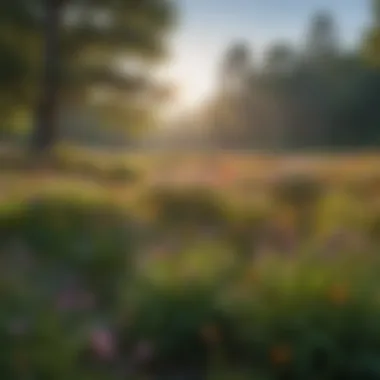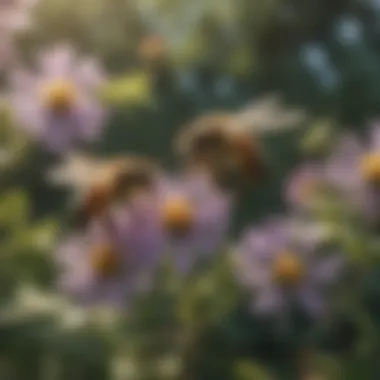The Role of Honey Bee Flowers in Summerville, GA


Intro
The intricate relationship between honey bees and the flowers they pollinate is of utmost importance. In Summerville, Georgia, this relationship is critical for sustaining local bee populations and ensuring biodiversity. Understanding the local flora that supports these essential pollinators is not just an academic pursuit but also a necessity for environmental stewardship and ecological health. This article aims to provide thorough insights on honey bee flowers in Summerville, focusing on their ecological significance and the best practices for fostering healthy bee habitats.
Understanding Woodland Ecosystems
Wooded areas provide an essential backdrop for the interaction between honey bees and native flora. The significance of these ecosystems extends beyond mere aesthetics; they form the foundation for a balanced environment.
Importance of Biodiversity in Forests
Biodiversity in forests is crucial for several reasons. A diverse range of plant species provides various nectar and pollen sources throughout the seasons, allowing honey bees to thrive. In Summerville, the presence of wildflowers, shrubs, and trees all contributes to this diversity.
- Nectar Availability: Different plants bloom at different times, ensuring bees have food year-round.
- Genetic Diversity: A variety of plants supports a broader genetic diversity among bee populations, aiding resilience against diseases.
Role of Forests in Climate Regulation
Forests play a significant role in climate control. They regulate temperatures, manage water cycles, and sequester carbon. These processes are vital to maintaining the health of bee populations and their habitats. Furthermore, healthy forests can mitigate the impact of climate change, which poses a threat to bee survival.
Sustainable Forestry Practices
Several practices promote long-term health for both forests and bee populations. Sustainable forestry recognizes the interconnectedness of all species within an ecosystem.
Principles of Sustainable Forestry
Adopting sustainable forestry practices ensures that the ecological balance is preserved. Key principles include:
- Selective Logging: Minimizes impact on bee habitats by cutting selectively rather than clear-cutting.
- Reforestation: Planting native species enhances the food sources for bees, promoting their populations.
Case Studies of Successful Implementations
Examples of successful sustainable forestry implementations can provide valuable lessons. For instance, regions that have practiced agroforestry—integrating crops and trees—have shown positive outcomes for pollinator health. The biodiversity introduced through thoughtful planning results in better pollination services and increased crop yields.
Woodland Stewardship Techniques
Stewardship techniques are essential for maintaining woodland health. They ensure that both flora and fauna, including honey bees, can coexist harmoniously in an area.
Forest Management Plans
Creating comprehensive forest management plans is vital. These plans should include objectives that address the needs of both honey bees and the wider ecosystem. Components may include:
- Monitoring Bee Populations: Understanding the dynamics of local pollinator populations can provide insights into biodiversity needs.
- Planting for Pollinators: Encouraging the growth of specific plants that are known to attract honey bees can sustain their populations.
Conservation Strategies
Developing targeted conservation strategies is necessary for protecting both the flora that supports honey bees and the bees themselves. These strategies might entail:
- Community Engagement: Involving the local community in planting initiatives helps raise awareness and foster stewardship.
- Research and Education: Promoting studies on local flora can lead to better-informed decisions and practices that benefit all.
Overall, understanding the connection between honey bee flowers and their ecosystems fosters a more profound respect for nature and its intricacies. This relationship is worth exploring for the sake of biodiversity and sustainability.
Prelims to Honey Bees and Their Importance
Honey bees play a critical role in ecosystems worldwide, notably influencing biodiversity and agriculture. This section outlines the multifaceted importance of honey bees, particularly within the context of Summerville, Georgia. Understanding their significance allows stakeholders, from local beekeepers to environmentalists, to implement more effective conservation strategies.
Understanding Honey Bees
Honey bees, primarily Apis mellifera, are often considered the backbone of pollination in many environments. Their biological structure is uniquely suited for this purpose. A honey bee’s body is covered in tiny hairs that can collect and transport pollen from one flower to another. This simple yet effective design facilitates the reproduction of many flowering plants, which is crucial for sustaining plant diversity.
Moreover, honey bees live in highly organized social colonies, each with roles divided among the queen, workers, and drones. Workers are primarily responsible for foraging, nest maintenance, and taking care of the young. This complex social structure enables honey bees to thrive in diverse environments by utilizing their collective efforts effectively.
In Summerville, the diverse flora created opportunities for honey bees to flourish. Understanding both the biology of honey bees and their social system enhances the appreciation of their role in local ecosystems.
The Role of Pollination
Pollination is not merely a benefit for honey bees; it is crucial for the viability of many plants. Honey bees are responsible for the pollination of approximately one-third of the food crops we consume, and this figure includes fruits, vegetables, and nuts. In Summerville, the local flora is adapted to attract these pollinators, revealing an intricate relationship that promotes biodiversity.
The process of pollination by bees leads to successful fertilization of plants, which ultimately ensures the production of seeds and fruits. This natural process has various ecological implications, including:
- Increased Agricultural Productivity: Effective pollination can lead to higher yields of crops, ensuring food security.
- Enhanced Biodiversity: Diverse plant life leads to richer habitats for other wildlife.
- Economic Value: Many local economies benefit from agriculture linked to pollination.
"Pollination by honey bees is vital not only for food production but also for maintaining a healthy ecological balance."


In summary, understanding honey bees and their role in pollination is essential for recognizing their value in Summerville. Through this insight, actionable steps can be taken to promote and protect these essential pollinators.
Overview of Flora in Summerville, GA
Understanding the flora of Summerville, Georgia, is vital for appreciating its unique ecosystem and the role it plays in supporting honey bees. The variety of plant species in this area contributes to both the aesthetic beauty and ecological health of the region. Not only do these plants provide honey bees with necessary food sources, but they also promote biodiversity and ecosystem balance.
The local flora is a complex interrelationship of different species, each contributing to the environment in distinct ways. By examining this diversity, we can identify the plants that are most beneficial for honey bees, as well as those that are crucial for maintaining a robust ecosystem in Summerville. The study of these plants is also important in light of human activities that threaten their existence, potentially impacting honey bee populations and, by extension, agricultural productivity.
Diversity of Plant Species
The tapestry of plant species within Summerville is rich and varied, stemming from both native and non-native origins. This diversity plays a critical role in attracting honey bees. Various flowering plants bloom at different times throughout the seasons, which ensures a continuous food supply for these pollinators.
The diversity within local flora can be categorized into several habitat types:
- Wetlands: These areas are crucial for plant species that thrive in moist conditions, like swamp milkweed or various sedge grasses.
- Woodlands: Offering shelter and shade, woodland areas host many trees and understory plants providing nectar and pollen.
- Meadows: Open sunny spaces are often filled with wildflowers, offering abundant food sources during the warmer months.
Each of these habitats supports a unique set of plant species that interact with honey bees differently. The interdependence between these plants and honey bees exemplifies the necessity of conserving diverse habitats for both pollinators and plant life.
Common Native Plants
Focusing on native plants is essential when discussing the flora in Summerville. These plants have adapted to the local climate, soil conditions, and have co-evolved with regional pollinators like honey bees. Some common native flora include:
- Black-eyed Susan: This perennial flower is bright and appealing to bees, blooming in the late summer.
- Coneflower (Echinacea): Known for its medicinal properties, it also serves as a great nectar source for honey bees.
- Butterfly Weed: Not only attracts honey bees, but also serves as a magnet for other pollinators like butterflies.
By prioritizing these local plants, residents and conservationists can foster healthier environments that support honey bee populations.
"Promoting the cultivation of native plants is a key step toward ensuring the health of local bee populations."
The significance of this section is clear. The flora of Summerville serves not just as a backdrop but as an active participant in the health of honey bee populations and overall biodiversity. Understanding and protecting this flora benefits both the bees and the ecosystem as a whole.
Major Honey Bee Flower Varieties in Summerville
The presence of honey bee flowers in Summerville is crucial for sustaining local bee populations. These flowers provide essential sources of nectar and pollen, which are vital for the health of honey bees. A diverse range of flowering plants enhances the ecosystem, promoting not only bee health but also the overall biodiversity of the area. Bees need access to high-quality food sources throughout their active seasons. Thus, understanding the varieties of honey bee flowers available in Summerville is significant for conservation efforts and local agriculture.
Flowering Plants Favorable for Honey Bees
Several flowering plants stand out as particularly beneficial for honey bees in Summerville. These plants bloom at different times throughout the year, offering a continuous supply of nutrients for the bees. Some of the most favorable species include:
- Clover (Trifolium spp.): Known for its high nectar yield, clover thrives in Summerville's soil and climate.
- Black-eyed Susan (Rudbeckia hirta): This perennial flower not only attracts bees but also other pollinators, boosting local insect populations.
- Wildflowers: Native wildflowers, including milkweed (Asclepias spp.) and goldenrods, contribute significantly to bee diets.
- Sunflowers (Helianthus annuus): Known for their large, pollen-rich blooms, sunflowers are easy to grow and very attractive to bees.
Each of these species offers a flavorful resource for bees, vital for honey production and colony health. The variety ensures that as some flowers fade, others bloom, thus sustaining the honey bee populations throughout different seasons.
Seasonal Bloom Patterns
Understanding the bloom patterns of honey bee flowers helps in planning for conservation and gardening. In Summerville, the flowering cycles follow a seasonal rhythm. Key bloom periods include:
- Spring: Early bloomers like wildflowers and clover begin to pop up, providing essential nutrition after winter dormancy.
- Summer: As temperatures warm, sunflowers and black-eyed Susans reach full bloom. This is the most abundant time for nectar and pollen, which supports honey bee colonies.
- Fall: Goldenrods and asters offer flowers late in the season, helping bees prepare for winter.
By incorporating a mix of these flowering plants into local gardens and landscapes, residents can create environments that support honey bee health. It is important for citizens to recognize these patterns and plant accordingly, ensuring that local biodiversity flourishes.
Impact of Honey Bee Flowers on Local Ecosystem
The interplay between honey bee flowers and the local ecosystem in Summerville is an intricate and essential one. The presence of diverse flowering plants is critical for sustaining honey bee populations, which in turn holds significant implications for the ecological balance in the region. Honey bee flowers serve as primary food sources; they provide nectar and pollen that are vital for honey bees' survival and reproduction. This relationship not only affects the bees but also supports broader ecological health, ensuring stability in both plant and animal populations.
Contribution to Biodiversity
The contribution of honey bee flowers to biodiversity cannot be overstated. Many flowering plants depend on honey bees for effective pollination. This interaction enhances genetic diversity within plant species, promoting resilience against diseases and environmental changes.
- Native Flora: The local flora in Summerville encompasses a range of native species that have evolved alongside honey bees. Examples include the vibrant Black-eyed Susan and the fragrant Wild Bergamot. Their unique adaptations, such as flower color and scent, attract honey bees effectively.
- Supporting Wildlife: A diverse array of flowering plants not only benefits honey bees but also supports other pollinators and wildlife, fostering a balanced ecosystem. The establishment of these relationships illustrates the complex web of dependencies that exist in natural habitats.
This emphasis on biodiversity is a foundation of ecological health; by promoting a variety of flowering plants, we are enhancing habitat quality for a range of species.
Honey Bees and Plant Reproduction
Honey bees play a pivotal role in the reproductive processes of many flowering plants. Through pollination, they facilitate the transfer of pollen from one flower to another, promoting fertilization and the development of seeds and fruits. Without this interaction, many plants could suffer reduced reproduction rates.
- Cross-Pollination: This process encourages genetic mixing, which leads to stronger plant populations. Cross-pollination results in increased fruit and seed production, promoting plant abundance in habitats. As a result, local flora can thrive, creating a richer biodiversity.
- Impact on Food Supply: Furthermore, plants that are successfully pollinated provide food resources not just for honey bees but also for other species in the ecosystem, including humans. Fruits and vegetables derived from these processes are essential in sustaining both local wildlife and communities.
Challenges Facing Honey Bees in Summerville
Understanding the challenges facing honey bees in Summerville, Georgia, is crucial for supporting their populations and ensuring ecological balance. Various threats compromise the well-being of these essential pollinators. As we unravel these challenges, we can find avenues for action to promote healthier environments for honey bees.
Habitat Loss


Habitat loss stands as a significant issue for honey bees in Summerville. Rapid urbanization, agricultural expansion, and land development lead to extensive modifications of natural landscapes. As natural habitats are destroyed, bees struggle to find sufficient food and nesting sites. The result is not just a decline in bee populations, but also a detrimental impact on the local ecosystem. Without adequate flowering plants, honey bees face starvation during critical seasons.
To address habitat loss, consideration should be given to creating buffer zones around development areas. Encouraging native plant planting in urban settings can help restore lost habitats. Land owners and communities are urged to maintain greenery by allowing wildflowers to flourish. This sustains not only honey bee populations but also promotes greater biodiversity.
Pesticides and Chemicals
Pesticides and chemicals pose another serious threat to honey bees. The use of these substances in agriculture aims to protect crops from pests, yet their impact on pollinators is alarming. Honey bees can be exposed to harmful chemicals through forage or contaminated water sources. This exposure can result in impaired navigation, reduced reproduction, and, in severe cases, population collapse.
Mitigating this challenge requires a multifaceted approach. Education of farmers about bee-friendly pest control methods is essential. Integrated pest management can help balance crop protection and pollinator health. Furthermore, advocating for organic farming practices can significantly reduce the reliance on harmful chemicals. Local regulations can play a role by limiting pesticide use during peak foraging times for honey bees.
"Addressing environmental threats to honey bees is essential for our sustainable future, ensuring biodiversity and ecological health."
By tackling issues like habitat loss and pesticide impact, communities can significantly affect honey bee conservation efforts in Summerville. It is critical to recognize these challenges to create a supportive environment for honey bees and enhance the local ecosystem.
Best Practices for Supporting Honey Bee Habitats
Supporting honey bee habitats entails practical actions that contribute to the well-being of bee populations and the broader ecosystem. This section discusses the significance of this topic in Summerville, highlighting that cultivated spaces can greatly enhance biodiversity while creating environments suited for honey bees. Understanding the challenges faced by bees today allows for more informed interventions. Enhancing habitats is not only a benefit for honey bees but fosters overall ecological health.
Creating Bee-Friendly Gardens
Establishing bee-friendly gardens is a fundamental practice in supporting honey bee habitats. Such gardens prioritize flowering plants that provide continual nourishment throughout various seasons. By incorporating a diverse array of native flowers, garden designers can create an inviting space for local pollinators. Native plants, such as Echinacea purpurea (purple coneflower) and Monarda didyma (bee balm), attract bees while being adapted to local environmental conditions.
Additionally, it is crucial to avoid chemical pesticides or herbicides that could harm bees. Instead, organic gardening practices should be embraced. These include using natural fertilizers and employing pest management strategies that are non-toxic to honey bees. Gardening practices such as mulching and composting also support soil health, enhancing plant growth and longevity.
Other strategies for creating bee-friendly gardens include:
- Providing Nesting Sites: Leaving small patches of bare ground and incorporating bee hotels can promote nesting.
- Water Sources: Including shallow dishes with water can help bees stay hydrated, especially in hot months.
- Minimizing Lawn Area: Reducing the size of turf grass lawns in favor of flowering plants allows for more bee forage.
Community Involvement and Education
Involving the community in honey bee conservation initiatives is vital for fostering awareness and action. Educational programs can equip individuals with knowledge about the importance of bees, their declining populations, and practical steps they can take to create bee-friendly environments. Workshops, seminars, and local events serve as platforms for sharing knowledge and solutions.
Schools can create programs that involve students in gardening projects, enabling youngsters to learn about plant life cycles, pollination, and the ecological roles of bees first-hand. Encouraging participation in native plant sales or community gardens centered on bee-friendly flora can strengthen community ties while promoting sustainability.
Efforts should be made to disseminate information through various platforms:
- Social Media Campaigns: Utilizing platforms like Facebook and Reddit to spread awareness and share success stories.
- Local Newsletters: Regular updates on bee-friendly practices and local flora can keep the community informed.
- Partnerships with Local Organizations: Collaborating with ecological groups can amplify reach and broaden impact.
"Community involvement is transformative. When people learn together and act, changes compound, benefitting honey bees and the environment alike."
Incorporating these practices enhances not only honey bee habitats but promotes a thriving ecosystem in Summerville.
The Interconnection Between Trees and Honey Bees
The relationship between trees and honey bees is a crucial aspect of the ecological balance in Summerville, GA. Trees provide an array of benefits that directly support honey bee populations. Understanding this interconnection is essential for appreciating how local ecosystems function and thrive. The presence of trees enhances the habitat quality for bees, which in turn contributes to successful pollination and honey production.
Trees as Nectar Sources
Trees are invaluable nectar sources for honey bees. Many tree species produce nectar-rich flowers, which attract bees during the blooming season. For instance, flowering dogwoods and red maples are among the first trees to bloom in early spring, supplying bees with a much-needed resource after the winter months. Other trees like tulip poplar and black locust continue to provide nectar throughout different seasons.
The availability of nectar from trees supports bee health and increases their foraging activity. This leads to improved pollination of both wildflowers and agricultural crops. Additionally, bees that feed on diverse nectar sources develop stronger immune systems. Thus, the interconnectedness of trees and bees extends beyond mere food sources; it fuels wider ecological relationships that benefit the entire environment.
Protecting Forested Areas
Conserving forests is essential for the survival of honey bees in Summerville. Deforestation and urban development threaten the habitats that trees provide. As forested areas diminish, so do the nectar and pollen resources critical for bees. Protecting forests ensures that these vital sources remain intact.
Community initiatives aimed at reforestation and conservation can have a significant impact on honey bee populations. Engaging local residents in tree planting and habitat restoration efforts helps to create awareness about the vital link between trees and bees. Further, policy improvements aimed at protecting existing woodlands can promote sustainability.
"The preservation of forested areas not only supports honey bees but also enhances biodiversity and maintains ecosystem stability."
In summary, the role of trees as nectar providers and the need for their conservation are pivotal for supporting honey bee populations in Summerville. By fostering an awareness of these issues, communities can work together to create a healthier environment for both trees and bees.
Ecological Significance of Honey Bees
Honey bees play a vital role in maintaining the ecological balance within their ecosystems. Their activities significantly impact both plant and animal life, which creates a diverse and healthy environment in Summerville, Georgia. In this section, we shall explore the importance of honey bees, particularly focusing on their contribution to honey production and their essential role in food production through pollination.
Honey Production
Honey production is perhaps the most recognized benefit of honey bees. The process begins when honey bees collect nectar from flowers. This nectar is then transported back to the hive, where it undergoes a process of regurgitation and evaporation. Through this, the nectar is transformed into honey. The significance of this process extends beyond just producing a sweet substance for human consumption.
- Honey serves as a source of energy for bees during winter months.
- It has antibacterial properties, which aid in preserving the hive's health.
- The business of honey production also supports local economies. Many beekeepers in the region contribute to the agricultural sector by selling honey, which in turn promotes local markets.


Furthermore, the honey produced by bees contains several essential nutrients that can benefit human health. It is rich in antioxidants and can be a natural sweetener, promoting a more sustainable lifestyle by reducing reliance on processed sugars.
Role in Food Production
Honey bees are key players in food production due to their role as pollinators. Pollination occurs when bees transfer pollen from one flower to another, leading to fertilization and, ultimately, seed and fruit development. This process is essential for a wide variety of crops, both domesticated and wild.
The following crops depend significantly on honey bee pollination:
- Apples
- Blueberries
- Almonds
- Cucumbers
- Melons
The economic contribution of honey bees through pollination is substantial. It is estimated that pollinators, including honey bees, are responsible for one-third of the food produced for human consumption. Beyond commercial agriculture, bees also facilitate the growth of wild plants that support local wildlife.
The connection between honey bees and food production is profound. Without their pollinating efforts, many fruits, vegetables, and nuts would become scarce, impacting both the environment and our diets.
Understanding the ecological significance of honey bees in Summerville underscores the necessity of protecting their habitats. By appreciating their contributions to honey production and food production, we can take actionable steps in conservation efforts targeted at maintaining healthy bee populations.
Samplings and Research in Summerville
Research on honey bee flowers is pivotal in understanding the local ecosystem in Summerville, Georgia. Exploring this area provides insights into how specific flora supports honey bee populations and their interactions within the environment. Scientific investigations allow us to catalog the various species that play crucial roles in pollination. Additionally, they inform us about the health of these bee populations, which is an indicator of environmental vitality. The data gleaned from samplings can also help guide conservation efforts and policies aimed at sustaining bee habitats.
Field Studies
Field studies in Summerville focus on observing and documenting flowering plants that attract honey bees. These observations occur during different seasons, capturing the blooming cycles of plants such as clover, wildflowers, and native shrubs. Such studies provide valuable data on the quantity and diversity of flowers available to bees. Researchers typically utilize methods such as floral surveys and identification charts to recognize plant species and their blooming periods.
These studies can lead to several important findings, including:
- Identification of key nectar sources for honey bees.
- Assessment of how local environmental conditions affect plant growth and blooming.
- Insights into the patterns of bee foraging behavior.
Data on Pollinator Populations
Understanding pollinator populations is essential for determining the overall health of the ecosystem. In Summerville, data collection efforts incorporate direct observation and monitoring techniques. Researchers catalog the species of honey bees, their population densities, and their visiting frequency to flowers. Through this process, they can establish the relationships between bee populations and the diverse flora in the area.
Some key metrics gathered from this data include:
- The diversity index of bee species present.
- Trends in population changes over time.
- Correlation of pollinator health to flower availability.
This information is instrumental in conservation strategies, as it identifies areas that may be in need of more protected habitats or community initiatives. Through continuous research and sampling, the community can gain a clearer understanding of its role in supporting vital bee populations.
Future Directions for Honey Bee Conservation
The conservation of honey bees is an urgent topic deserving of thoughtful attention, especially in the changing habitats of Summerville, Georgia. This section discusses several innovative approaches and legislative efforts fundamental for the sustainability of honey bee populations. Honey bees are not just critical for pollination; they play an essential role in maintaining ecological balance. Thus, the future direction of this conservation requires multifaceted strategies that encompass community involvement, education, and policy advocacy.
Innovative Approaches
In Summerville, innovative approaches to conservation could implement agricultural best practices that prioritize sustainable farming. These practices can include:
- Crop rotation to enhance soil health and reduce reliance on pesticides.
- Integrated pest management to control pests while minimizing harm to bees.
- Planting diverse flower species that bloom at different times to provide a year-round food source.
- Creating wildlife corridors that connect different environments, allowing bees to thrive.
Additionally, urban spaces can be transformed into pollinator-friendly areas. This transformation can include:
- Using native plants in landscaping, which are better suited for local bee species.
- Installing green roofs that incorporate flowering plants.
Community workshops can educate residents about these approaches, sharing practical knowledge on how to cultivate bee-friendly environments.
Legislation and Policy Efforts
Legislative actions play a pivotal role in shaping the future of honey bee conservation. Effective laws can directly protect bee habitats and regulate harmful substances. Important components may include:
- Establishing pollinator protection plans that outline necessary actions for local governments.
- Banning certain pesticides known to be harmful to honey bees, such as neonicotinoids.
- Promoting financial incentives for farmers who implement practices supportive of bee health.
Furthermore, policy efforts can facilitate collaborations among various stakeholders, including local governments, non-profit organizations, and agricultural entities to establish bee conservation programs.
"The collaboration of communities, scientists, and policymakers is essential for reversing the decline of honey bee populations."
Culmination
In concluding this exploration, it is clear that honey bee flowers play a crucial role in the ecosystem of Summerville, Georgia. The interdependence between honey bees and local flora is evident. These flowers not only provide essential nectar and pollen for bees but also contribute significantly to the broader health of the environment.
Summary of Findings
The article has outlined key findings regarding the variety of honey bee flowers found in Summerville. The diversity of these plants facilitates the sustenance of honey bee populations. Seasonal blooming patterns ensure that honey bees have a continuous food source throughout the year. Furthermore, native plant species, such as Echinacea purpurea and Asclepias tuberosa, serve specific roles in supporting these pollinators. This relationship highlights the importance of maintaining local flora for the well-being of honey bees and, consequently, the entire ecosystem.
"Supporting honey bee habitats is not just about saving bees; it's about preserving biodiversity and enhancing our natural world."
Call to Action for Community Engagement
To promote a sustainable environment, community involvement is vital. Residents of Summerville can take active steps to support honey bee habitats. Planting native flowers in gardens and public spaces is one impactful way. Additionally, educating others about the importance of pollinators can foster a greater appreciation and commitment to conservation efforts. Local workshops and educational programs will engage the community and raise awareness about the beneficial roles of honey bees. Collaboration between environmental groups, local government, and residents will create a unified approach to preserving both honey bees and the flora they depend on.
Overall, recognizing the vital role of honey bee flowers in maintaining ecological balance is imperative as we move towards sustainable practices in our communities.







